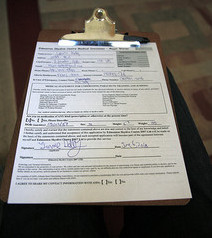By Doyice Cotten and Mary Cotten
 To be effective and stand up in court, a waiver must be clear, explicit and comprehensible. It must be easily readable and placed in such a way to compel notice. A waiver of liability may not be enforced if it is unlikely to be noticed and understood by the signer.
To be effective and stand up in court, a waiver must be clear, explicit and comprehensible. It must be easily readable and placed in such a way to compel notice. A waiver of liability may not be enforced if it is unlikely to be noticed and understood by the signer.
The important exculpatory language should be placed in a prominent position and must be distinguished from other sections of the document. A layperson should not be required to muddle through complex legalese in order to understand that valuable, legal rights are being relinquished. A significant factor that a judge looks at in determining whether or not to enforce a waiver is whether the language was so conspicuous that the signer of the waiver must have seen and understood the effect of the document.
Ways to draw attention to the exculpatory language:
- Print in a noticeably, different typeface from the remainder of the document.
- Use bold lettering for the key exculpatory language.
- Underline the exculpatory language.
- Use a different color for the exculpatory language.
- Use ALL UPPER-CASE letters for the key exculpatory language.
- Use a larger font than the remainder of the document.
- Set off the waiver language by a surrounding box.
- Separate it from the remainder of the document by spaces, dotted lines, or symbols.
- Immediately precede the paragraph containing the exculpatory language with a heading setting it apart; the heading should be made obvious by bold print, larger print, or some other method.
Mistakes to avoid:
10. Do not bury the exculpatory language in the middle of a long document far from the signature area.
11. Do not use a font size that is smaller than the remainder of the document and that is difficult to read; a font size of 8 is often considered the minimum.
12. Do not bury the key exculpatory language in the middle of an excessively long and wordy sentence that is surrounded by paragraphs of fine print.
13. Do not use a heading that is generic and deceptive. The heading should be descriptive and informative (e.g., Waiver of Liability; Release; Waiver of Rights; Waiver of Negligence).
14. Do not surround the waiver language with information regarding the inherent risks of the activity; keep information regarding inherent risk separate and, preferably in a separate section.
15. Make sure the language makes it clear that the signer is waiving liability for negligence of the provider.
Compare the following looks for the exculpatory language and decide which you think a court would think is the most easily read.
A. Upper-case letters for the entire exculpatory paragraph
IN CONSIDERATION OF PERMISSION TO USE THE PROPERTY, FACILITIES, EQUIPMENT, AND SERVICES OF XYZ, TODAY AND ON ALL FUTURE DATES, I, ON BEHALF OF MYSELF, MY SPOUSE, HEIRS, PERSONAL REPRESENTATIVES, AND ASSIGNS, DO HEREBY WAIVE, RELEASE, AND DISCHARGE XYZ FROM LIABILITY FROM ANY AND ALL CLAIMS ARISING FROM MY PARTICIPATION AT XYZ, INCLUDING THE ORDINARY NEGLIGENCE OF XYZ).
B. Bold for the entire exculpatory paragraph
In consideration of permission to use the property, facilities, equipment, and services of XYZ, today and on all future dates, I, on behalf of myself, my spouse, heirs, personal representatives, and assigns, do hereby waive, release, and discharge XYZ from liability from any and all claims arising from my participation at XYZ, including the ordinary negligence of XYZ.
C. Bold, upper-case letters for the key exculpatory language only
In consideration of permission to use the property, facilities, equipment, and services of XYZ, today and on all future dates, I, on behalf of myself, my spouse, heirs, personal representatives, and assigns, DO HEREBY WAIVE, RELEASE, AND DISCHARGE XYZ FROM LIABILITY FROM ANY AND ALL CLAIMS arising from my participation at XYZ, INCLUDING THE ORDINARY NEGLIGENCE OF XYZ.
D. Upper-case letters for the key exculpatory language only
In consideration of permission to use the property, facilities, equipment, and services of XYZ, today and on all future dates, I, on behalf of myself, my spouse, heirs, personal representatives, and assigns, DO HEREBY WAIVE, RELEASE, AND DISCHARGE XYZ FROM LIABILITY FROM ANY AND ALL CLAIMS arising from my participation at XYZ, INCLUDING THE ORDINARY NEGLIGENCE OF XYZ).
E. Bold letters for the key exculpatory language only
In consideration of permission to use the property, facilities, equipment, and services of XYZ, today and on all future dates, I, on behalf of myself, my spouse, heirs, personal representatives, and assigns, do hereby waive, release, and discharge XYZ from liability from any and all claims arising from my participation at XYZ, including the ordinary negligence of XYZ).
As to which of these five formats is best, the writer can’t say. However, it is easy to say which is worst – Option A. Notice how difficult it is to read. It takes more effort than the others. Research confirms documents written in all upper-case letters are significantly more difficult to understand. Another that I would discard is Option B. The bold certainly will set it off from the remainder of the document, but it is very difficult to ferret out the key language within the paragraph. Options C, D, and E are relatively equal and depend somewhat upon personal preference; Options C and D, however, may be slightly more difficult to read because of the upper-case wording. My personal preference is Option E. Note how key language is brought to the attention of the signer. But regardless of which option you choose, if you follow these suggestions and make your waiver more obvious, it is more likely to provide the protection for which you are striving.
Photo Credit: Thanks to Lewis Kelly at http://www.flickr.com/photos/43190831@N07/4679623974/sizes/n/in/photostream/
